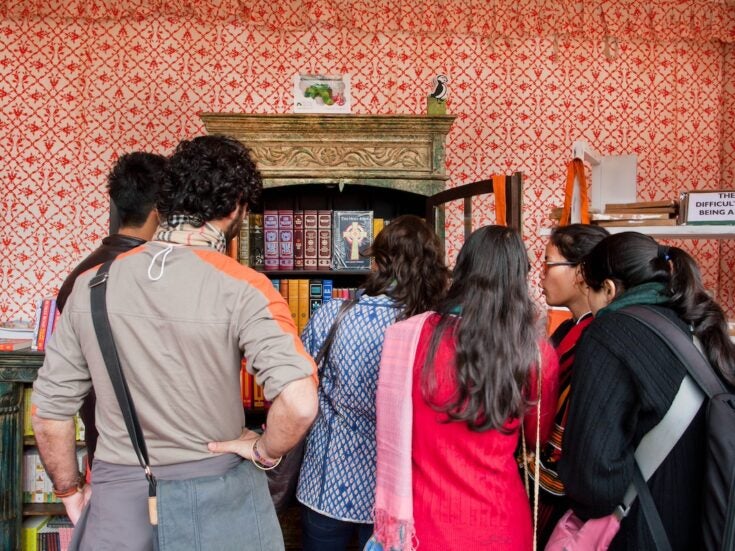
Anthony Haden-Guest talks to the inseparable duo Gilbert and George, whose every waking moment is Art
NIGEL GREENWOOD, A friend, had one of the very few London galleries that showed ‘serious’ Contemporary art in the early Seventies — there were four of them, according to his obit in The Guardian a few years ago, the Lisson being the only survivor — which was a time when the fat, rambunctious art world of today was a glimmer in nobody’s eye. The gallery was just off Sloane Square and it was there that Greenwood took me to watch two fellows, wearing early Beatles-type suits and metallic face-paint, standing on a table and miming to Flanagan and Allen’s bittersweet tramp song Underneath the Arches on a gramophone.
This was my introduction to Gilbert and George and their Singing Sculpture, and I left with a booklet entitled To Be with Art Is All We Ask. They would perform, sometimes all day, for several weeks. Was this an example of what had only fairly recently been named Conceptual art? It was certainly thinky, but it was full of feeling, too.

Some years later I interviewed them for The Paris Review. And now here they were this spring in Lehmann Maupin, their New York gallery, for London Pictures, a show of pieces based on assemblages of the posters bearing screamy, scrawled headlines that you see at newspaper kiosks. Their suits were perhaps more stylishly cut — George’s tailor is Nicolas, near the Angel — but otherwise they seemed not greatly changed. Change indeed has never been what Gilbert and George are about. And that has been so since George, a Brit, and Gilbert, an Italian, met at St Martin’s School of Art in 1967, bonded and developed their dual but singular vision.
‘We felt that we were artists already,’ George said. ‘And all the students were plotting, planning how to become an artist — “How do you get an Arts Council grant? How do you write to the Gulbenkian Foundation? How do you get a free studio for a year?” And we didn’t think like that. First of all those things wouldn’t be available to a twosome anyway — there was no precedent for that. But we felt very secure.’
‘We did the Living Sculpture, like walking in Hyde Park, stuff like that,’ Gilbert added. ‘And we sent out cards, describing what’s going on — like, the snow is falling outside, we are drinking coffee. And how we felt that day.’
‘The so-called Social Sculptures,’ George said.
I noted that I still had the To Be with Art… booklet. ‘It’s considered a classic text,’ George said. ‘Extraordinary, that.’
‘There’s another booklet where we talk very much about art,’ Gilbert said. ‘Art is not an abstract word. Art is a human person that is walking in the Charing Cross Road. He is white, with blond hair. And when we try to approach him, he disappears. But he is human. That is what we like.’
‘And we kept to that,’ said George.
‘Nothing has changed,’ said Gilbert. ‘From the beginning. Was it by accident? Or maybe because we were naïve? No? But we had these rules: how to be artists. Like the Living Sculptures. And after that nothing has changed. And that was in ’68.’
They got off to a fast start. It was 1970, and they had been explicitly rejected for an exhibition where they felt they belonged, so they gatecrashed it as Living Sculpture. There they caught the eye of Konrad Fischer, who had opened a gallery in Düsseldorf in 1967 with a show of Carl Andre and was by then among the most powerful dealers in the newest of the new art in Europe.
‘And he said, “Why don’t you come and do something for me?”’ Gilbert said.
So Gilbert and George went out and made their Living Sculpture in Düsseldorf — ‘And one evening he said, “Why don’t you leave something behind that we can sell?”’ Gilbert said. They had never made anything to sell, so they produced some drawings. ‘They were charcoal drawings,’ Gilbert said, ‘six big drawings.’
‘Copied from photographs,’ added George. ‘We stained them with manganese potash because we didn’t want them to look modern.’
‘They were full of words,’ Gilbert said. ‘How we felt, walking the streets of London. We even included limericks. Six big drawings, and they all had text, limericks. And how we feel seriously for our fellow artists.’
‘Not true!’ George said. Both chuckled.
Gilbert said: ‘Then Konrad asked us, “How much should it be, then?”’
George said: ‘And not thinking for one second that we would sell something, because we hadn’t ever sold anything, we said, “Let’s just be grand and big-headed. If nobody’s going to buy it, it might as well be an exceptional price.” We said, “Oh, a thousand pounds.” He sold it the next day! We were amazed — that was enough money to last for a year in London.’
Had anybody ever referenced the Aesthetic Movement of the 1880s when discussing their work?
‘We rather like the Aesthetic Movement,’ said Gilbert. ‘We are big fans.’
‘We have a collection,’ said George. ‘We have a big collection of decorative art.’
Gilbert added: ‘They were kind of living sculptures — like Oscar Wilde. Don’t you think? Even so, at the same time the Aesthetic Movement was art about art? Isn’t that so, George? Form about form.’
‘Yes, it’s a contradiction,’ said George. ‘Wilde said there was no moral dimension to his writing; it was just beautiful words. Which wasn’t true.’
‘That’s what we are not,’ Gilbert said. ‘That’s the big difference. There’s a moral dimension.’
George said: ‘Young people say, “Art for fuck’s sake.” The trendies!’

GILBERT AND GEORGE are not partial to trendies. They were keen supporters of Margaret Thatcher. And this is culturally, if not necessarily politically, in keeping with their rootedness in the raw Britishry of London’s East End. They were living in a house in Fournier Street, Spitalfields, when I interviewed them for The Paris Review and they still live there. The East somewhat poshed up here and there but, like New York’s Lower East Side, it is what it is.
As Gilbert and George are what they are. Which is, they say, a single artist. But just how does that work in practice? As an individual, I said, I often argue with myself. But there are two of you. And you are one artist? You must sometimes argue?
‘No! We call that the Great Heterosexual Question,’ George said, ‘because in plays and books men always seem to be arguers. But we don’t think we need to do that.’
Gilbert said: ‘Because in the end we have to succeed. And we have to withstand compromises inside ourselves.’
‘Without discussion,’ George said.
Gilbert said: ‘Because the idea is always in front of us. Because we are always together, no? So when a subject comes up, a new subject, and we are going towards it, it doesn’t matter if the ways are a little different. But the main subject has to stay the same. We don’t compromise on that. But the ways can be different.’

George said: ‘Why should I interfere with something that’s going on while we’re doing it? It’s counterproductive.’
Gilbert said: ‘We learned to do it.’
‘It’s magical!’ George said. ‘Magical! Magical!’
But (and I indicated the London Pictures) we see these placards… I’ve been seeing them all my life. They are found objects… one of you must have said, ‘What about that?’
‘No!’ exclaimed George.
‘It was very slow motion,’ Gilbert said.
New York can sometimes erase distinctions, but just as often it can accentuate them, and the London Pictures were looking hauntingly London-soaked, not least because those screamy newsstand posters which used to be ubiquitous when I came to Manhattan now seem as redolent of the past as Sherlock Holmes, Alec Guinness in Ealing comedies and hansom cabs. As they will some day, perhaps soon, be history in London, too.
Read more by Anthony Haden-Guest







